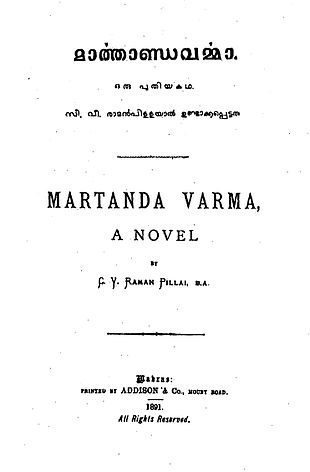Marthandavarma (novel)

Title page of the first edition
|
|
| Author | C.V. Raman Pillai |
|---|---|
| Original title | മാർത്താണ്ഡവർമ്മ |
| Translator | B. K. Menon (1936 – English) O. Krishna Pillai (1954 – Tamil) R. Leela Devi (1979 – English) Kunnukuzhy Krishnankutty (1990 – Hindi) P. Padmanabhan Thambi (2007 – Tamil) |
| Country | India |
| Language | Malayalam |
| Genre |
Historical Novel Historical Romance |
| Set in | Travancore (1727 – 1732) |
| Published |
Malayalam :
English :
Tamil :
Hindi :
|
| Media type | Print (Paperback) |
| ISBN | (D. C. Books ed.) |
| Followed by | Dharmaraja, Ramarajabahadur |
|
Original text
|
at Malayalam |
Malayalam :
English :
Tamil :
Hindi :
Marthandavarma (Malayalam: മാർത്താണ്ഡവർമ്മ, Māṟttāṇḍavaṟmma [mɑːṟt̪t̪ɑːɳɖaʋaṟmma]) is a historical romance novel by C. V. Raman Pillai published in 1891. It recounts the history of Venad (Travancore) during the final period of Rajah Rama Varma’s reign and subsequently to the accession of Marthanda Varma. Set in Kollavarsham 901–906 (Gregorian calendar: 1727–1732), the story revolves around three protagonists, Ananthapadmanabhan, Subhadra and Mangoikkal Kuruppu, who try to protect the title character from Padmanabhan Thambi and Ettu Veetil Pillamar who plan to oust him from the throne of Travancore. The novel utilizes rich allusions to the Indian subcontinent and Western, historical, cultural and literary traditions.
The historical plot is aided with the love story of one of the lead pairs, Ananthapadmanabhan and Parukutty, the chivalric actions of the former, and the aspects of romanticism in the longing of Parukutty for her lover as well as in the unrequited love of Zulaikha. The yesteryear politics of Venad is presented thru the council of Ettuveettil Pillas, the subsequent claim of throne for Padmanabhan Thambi, the coup attempt, the patriotic conduct of Subhadra, and finally to her tragedy following the suppression of revolt. The intertwined representation of history and romance is attained thru classic style of narration, which includes vernacular languages for various characters, rhetorical embellishments, and the blend of dramatic and archaic style of language suitably to the bygone period.
...
Wikipedia
